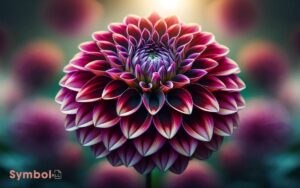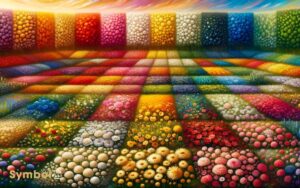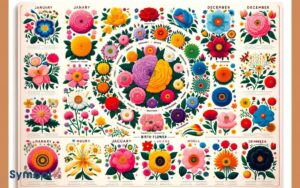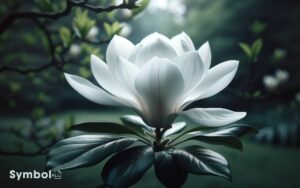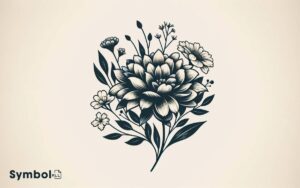What Does a Pink Flower Symbolize? Admiration!
Pink flowers symbolize a rich tapestry of emotions due to anthocyanins causing their varied pigmentation. Culturally and scientifically, these hues convey admiration, elegance, and deep affection.
Pink roses express gratitude and joy, while pink carnations reflect a deeper love, marked by historical significance. Cherry blossoms remind you of life’s fleeting nature, urging mindfulness. Pink gerberas embody grace and gratitude, capturing joyous moments.
Dahlias and hydrangeas, through their color and cultivation, signify dignity and heartfelt emotions, respectively. Lilies, with their regal appearance, symbolize wealth and prosperity.
Exploring the symbolic nuances of each shade and species reveals a deeper connection to these emotions.
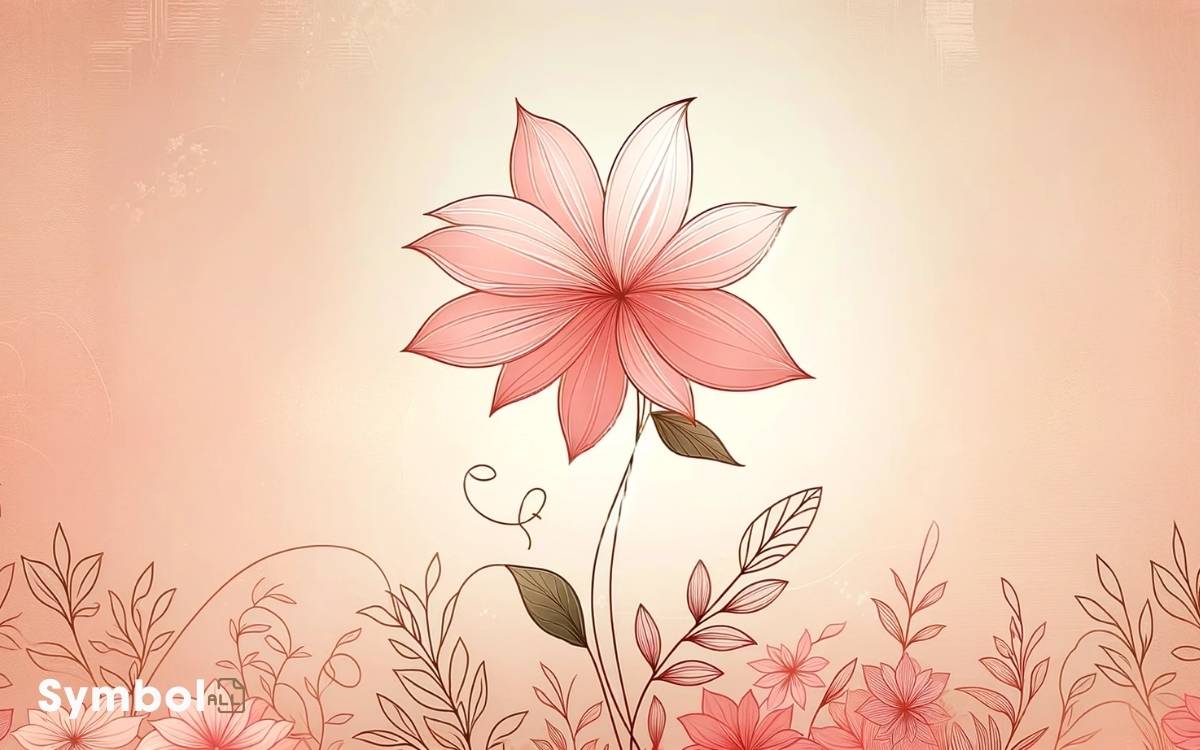
Key Takeaways
The Essence of Pink Flowers
Many pink flowers embody a complex array of symbolic meanings, ranging from affection and admiration to gratitude and grace, each with distinct scientific and cultural interpretations.
In the domain of botany, the pigmentation of pink in flowers is due to the presence of anthocyanins, which can vary in concentration, leading to the wide spectrum of pink shades observed.
This variation not only influences the plant’s attractiveness to pollinators but also carries a wealth of symbolic significance across different cultures.
For instance, in Japanese culture, the delicate cherry blossom, or Sakura, represents the transient nature of life, embodying both beauty and mortality. Meanwhile, in Western contexts, pink carnations are often associated with a mother’s enduring love, derived from Christian lore.
Analyzing these symbols, you’ll find that pink flowers offer a nuanced language of emotion and meaning, deeply rooted in both scientific phenomena and cultural narratives.
Pink Roses: Admiration and Elegance
Symbolizing both admiration and elegance, pink roses stand as a proof to the intricate interplay between botanical science and cultural significance.
You’ll find that the hue of a pink rose isn’t merely a result of its genetics but also its environment, illustrating how external factors influence its development.
Scientifically, the pigmentation in pink roses, primarily due to anthocyanins, varies with pH levels, light exposure, and temperature, showcasing nature’s complexity.
Culturally, these roses convey gratitude, grace, and joy, making them a popular choice for expressing admiration without the intensity of love that red roses imply.
Analyzing their usage in various ceremonies and events reveals their role in human social structures, symbolizing a refined gesture of respect and appreciation.
Carnations and Deep Affection
You’ll find that the color of a carnation holds significant meaning, ranging from deep affection to admiration.
The symbolic history of carnations is rich, tracing back to ancient cultures that revered these flowers for their emotional and medicinal properties.
Understanding the etiquette of gifting carnations can enhance the message you intend to convey, making them a thoughtful choice for various occasions.
Carnation Colors Meaning
Carnations, with their diverse palette of colors, carry deep-seated meanings that often denote affection and profound emotions. These flowers, scientifically termed Dianthus caryophyllus, exhibit a spectrum of hues, each conveying a unique sentiment.
Pink carnations, for instance, symbolize a mother’s undying love, making them a vital choice for Mother’s Day. The red variety, however, embodies deep love and admiration, akin to that of a romantic partner.
White carnations are tied to pure love and good luck, while striped ones suggest regret that a love can’t be shared.
It’s essential to select the appropriate color to accurately convey your emotions, as each shade encapsulates a specific message rooted in cultural and historical significance.
Symbolic History of Carnations
Understanding the nuanced meanings behind the colors of carnations leads us naturally to explore their rich symbolic history, deeply intertwined with human affection and cultural practices. Historically, carnations have conveyed messages of love, fascination, and distinction.
Scientific analysis reveals that their enduring appeal may stem from their vast range of colors, each carrying distinct emotional resonances.
Specifically, the pink carnation symbolizes a mother’s undying love, deriving from Christian legend that pink carnations first appeared from the Virgin Mary’s tears – a confirmation of unconditional love.
This symbolism has permeated various cultures, making pink carnations a global emblem for motherly affection. Their long-lasting nature and resilience mirror the enduring quality of deep affection, reinforcing their role in expressing profound human emotions.
Gifting Carnations: Etiquette
When choosing carnations as a gift, it’s vital to consider their color symbolism and the message you wish to convey, reflecting the depth of your affection.
Carnations, with their diverse range of hues, embody intricate emotional messages. For example, deep red carnations represent profound love and admiration, making them perfect for romantic gestures.
Conversely, pink carnations, stemming from a legend of the Virgin Mary’s tears, symbolize a mother’s eternal love, making them ideal for Mother’s Day.
It’s important to align the carnation’s color with the desired sentiment, ensuring your gift conveys the exact emotion.
This practice, based on the principles of floriography, enriches the meaningful exchange between giver and recipient, emphasizing the significance of selecting the right color to accurately express the depth of your feelings.
Cherry Blossoms: Life’s Fleeting Beauty
You observe cherry blossoms and their ephemeral beauty, which holds profound significance in Japanese culture, symbolizing both renewal and the embrace of impermanence.
This flora’s brief blooming period is a poignant reminder of life’s transient nature, deeply embedded in cultural ceremonies and artistic expressions.
Analyzing these aspects reveals the cherry blossom’s role as a metaphor for human existence, underlining the importance of mindfulness and the acceptance of life’s inherent fragility.
Significance in Japanese Culture
In Japanese culture, cherry blossoms symbolize the ephemeral nature of life, embodying its beauty and fleetingness with profound significance.
This symbolism is deeply ingrained in various aspects of Japanese society, reflecting a collective consciousness that appreciates the transient yet impactful moments of existence.
Scientifically, the cherry blossom’s brief blooming period serves as a potent metaphor for human life’s transient nature, encouraging mindfulness and the cherishing of fleeting beauty.
The blossoms’ delicate pink hues and short-lived blooming cycle are often associated with the impermanence of youth and beauty, highlighting a philosophical acceptance of life’s cyclical and temporary phases.
This cultural emblem, therefore, offers a nuanced lens through which the Japanese view and celebrate the temporal beauty of life’s stages, promoting a deeper appreciation for momentary splendors.
Symbolism of Renewal
Beyond their ephemeral beauty, cherry blossoms also embody the powerful symbol of renewal, marking the arrival of spring with their vibrant bloom. This phenomenon is not just a visual spectacle but serves as a metaphor for the cyclical nature of life and ecosystems.
As cherry blossoms flourish, they signify the rejuvenation of flora and the awakening of fauna, catalyzing a series of ecological interactions that underscore the interconnectedness of living organisms.
| Aspect | Description | Significance |
|---|---|---|
| Vibrant Bloom | Marks the onset of spring | Symbolizes life’s renewal |
| Ephemeral Beauty | Brief lifespan of blossoms | Reflects fleeting nature of life |
| Ecological Impact | Triggers rejuvenation of flora and fauna | Demonstrates interconnectedness |
This detailed analysis highlights the cherry blossom’s role in symbolizing renewal, serving as a reminder of life’s continuous cycle of rebirth and regeneration.
Embrace of Impermanence
While cherry blossoms symbolize the renewal of life, they also teach us the profound lesson of life’s fleeting beauty through their embrace of impermanence.
These blossoms, scientifically known as Prunus serrulata, peak in a vivid display of pink, only to wither away within a fortnight.
This transient nature serves as a metaphor for the ephemeral quality of existence, urging you to appreciate moments of beauty and joy.
The biological cycle of cherry blossoms, from bud to bloom to eventual fall, mirrors human life stages, emphasizing the inevitability of change and the importance of living in the present.
Peonies: Prosperity and Bashfulness
Peonies symbolize both prosperity and bashfulness, reflecting a complex interplay of cultural and botanical significances. In your garden, these flowers aren’t just a burst of beauty; they’re steeped in symbolism and history.
Scientifically, Paeonia spp. thrive in temperate climates, showcasing their resilience and lush growth, which mirrors the idea of prosperity.
The layers of petals, delicate and numerous, contribute to their association with wealth and honor in various cultures, especially in Eastern traditions.
Conversely, their bashful aspect is drawn from their tendency to bloom hidden among large foliage. This characteristic has led to their symbolic connection with shyness and modesty.
Analyzing their growth patterns and reproductive strategies offers insights into how these meanings have evolved.
Peonies’ dual symbolism enriches your understanding of floral language, adding depth beyond their visual appeal.
Tulips: Care and Good Wishes
Tulips, embodying care and good wishes, require specific horticultural practices to flourish and express their full symbolic potential. You’ll find that to nurture these blooms, an understanding of their needs is essential.
Tulips thrive in well-drained soil, benefit from chill periods before growth, and demand careful attention to watering schedules.
Their care mirrors the care you’d offer a cherished friend, emphasizing the importance of providing just the right conditions for growth and vitality.
| Aspect | Requirement | Symbolism |
|---|---|---|
| Soil | Well-drained | Foundation for growth |
| Temperature | Cool pre-growth | Preparation for life |
| Watering | Moderate | Nurturing environment |
| Light | Full sun to partial | Exposure to warmth |
This table encapsulates the essence of tulip care, aligning with the good wishes they symbolize.
Azaleas: Femininity and Family Ties
Azaleas, symbolizing femininity and family ties, require specific environmental conditions to thrive and convey their deep-rooted meanings effectively.
In the domain of botany, these flowers exhibit a strong correlation between their blooming environment and the symbolic significance they hold.
For azaleas, well-drained, slightly acidic soil is paramount, mirroring the nuanced and complex nature of femininity and the intricacies of family relationships.
Their dependency on a particular pH level for best growth reflects the delicate balance needed in familial bonds and the nurturing aspect of femininity.
Additionally, the azalea’s propensity for blooming in clusters symbolizes the collective strength and unity within a family, emphasizing how individual contributions fortify familial ties.
This botanical analogy serves to deepen our understanding of the symbolic weight azaleas carry in expressing these human conditions.
Camellias: Longing and Desire
You’ll find that camellias, particularly in shades of pink, encapsulate a depth of emotion, symbolizing longing and desire across various cultures.
Their use in romantic gestures, from declarations of love to expressions of longing, is rooted in a complex interplay of historical context and botanical characteristics.
Different varieties of camellias carry nuanced meanings, making them a subject of interest for those studying the language of flowers.
Symbolism in Different Cultures
Across different cultures, camellias symbolize longing and desire, reflecting deep-seated emotional states through their vibrant hues and intricate petals.
These flowers, with their lush, layered blooms, convey emotions with a richness that transcends language barriers. The symbolism attributed to camellias varies, yet the theme of emotional depth remains constant.
| Culture | Symbolism | Color |
|---|---|---|
| Japanese | Waiting | Pink |
| Chinese | Admiring from afar | Red |
| Victorian | Deep longing | White |
These variations show how the camellia’s beauty and form have made it a versatile symbol across different societies.
Scientifically, the genus Camellia encompasses a wide range of species, each with unique characteristics that contribute to their symbolic meanings.
The specificity of color in symbolism is remarkable, as it underlines the camellia’s role in expressing complex human emotions without words.
Camellias in Romantic Gestures
Exploring the domain of romantic expressions, camellias, with their rich symbolism of longing and desire, often serve as profound tokens of affection between individuals.
Delving into their botanical and cultural significance reveals that these flowers embody a complex interplay of emotions and meanings.
Scientifically, the genus Camellia encompasses a variety of species, each with unique characteristics that amplify their symbolic weight in romantic contexts.
The physiological response they evoke in recipients ranging from increased dopamine levels to a sense of euphoria underscores their effectiveness as conveyors of deep-seated emotions.
Analytically, the choice of camellias in romantic gestures isn’t merely aesthetic but rooted in a nuanced understanding of their symbolism, offering a silent yet eloquent language of love and yearning.
Varieties and Their Meanings
Delving into the varieties of camellias reveals a nuanced palette of meanings, each color and type symbolizing different facets of longing and desire.
The intricate taxonomy of Camellia, encompassing over 200 species and thousands of hybrids, offers a fertile ground for analysis.
Specifically, the Camellia japonica species, with its broad spectrum of pink hues, from pale blush to deep rose, conveys messages of longing with remarkable specificity.
The intensity of the color correlates with the depth of one’s desire pale pink camellias express a gentle yearning, while darker shades signify a more profound and passionate longing.
This chromatic symbolism is grounded in the plant’s phenotypic variations, where pigmentation intensity is determined by anthocyanin concentrations, making each flower a complex emblem of human emotions.
Orchids: Delicate Strength
Symbolizing a blend of delicate beauty and surprising resilience, orchids embody the paradox of strength in gentleness, engaging observers with their intricate structures and varied hues.
You’ll find their resilience not just in their visual appeal but in their genetic makeup and adaptability. Orchids have evolved complex reproductive strategies and symbiotic relationships with pollinators and fungi, ensuring their survival across diverse environments.
This resilience makes the orchid a symbol of enduring love, a demonstration of lasting relationships that withstand trials.
Additionally, the varied colors of orchids, including the soft pink varieties, add layers of meaning. Pink orchids, in particular, denote grace, joy, and happiness, further enriching their symbolic complexity.
They’re not just flowers; they’re a study in the balance of nature’s delicate and robust aspects.
Gerberas: Cheerfulness and Innocence
You’ll find that Gerberas, with their wide range of color varieties, inherently symbolize moments of joy and innocence due to their bright and cheerful hues.
Analyzing the specific conditions under which Gerberas thrive highlights the importance of precise cultivation techniques to maintain their vibrant appearance and symbolic meaning.
The process of growing these flowers properly involves a detailed understanding of their environmental and nutritional needs, ensuring they continue to represent cheerfulness in the language of flowers.
Gerberas Color Varieties
Gerberas, known for their wide array of color varieties, epitomize cheerfulness and innocence through their vibrant hues and patterns. Each color signifies a unique aspect of emotion or sentiment, providing a rich palette for expressing various feelings.
The gerbera’s structure, with its large flowering head comprising hundreds of individual petals, allows for a spectacular display of color. Scientifically, these colors result from the plant’s genetic makeup and environmental factors influencing pigment production.
For instance, carotenoids yield yellows and oranges, while anthocyanins are responsible for reds and purples.
This diversity in coloration isn’t just aesthetically pleasing; it plays an important role in attracting pollinators, ensuring the species’ survival and propagation. Understanding the gerbera’s color spectrum reveals a deeper insight into its biological and ecological significance.
Symbolizing Joyful Moments
Capturing the essence of cheerfulness and innocence, gerberas serve as vibrant messengers of joyful moments through their vivid coloration and floral structure.
These flowers, characterized by their large, daisy-like appearance, exhibit a wide range of hues, each conveying a different emotional nuance.
Specifically, pink gerberas symbolize admiration, grace, and gratitude, making them ideal for expressing affection and appreciation.
Scientifically, the gerbera’s morphology, including its capitulum which clusters hundreds of individual flowers together, enhances its visual appeal, thereby intensifying its symbolic message of happiness and purity.
The flower’s ability to evoke positive emotions is further supported by psychological studies on color theory, which suggest that bright colors can significantly influence human mood and perception, reinforcing the gerbera’s role in symbolizing joyful moments.
Cultivating Gerberas Properly
To successfully cultivate gerberas, often symbolizing cheerfulness and innocence, one must follow specific horticultural practices that guarantee their vibrant growth and bloom.
Initially, make sure gerberas are planted in well-draining soil to prevent root rot, a common issue with these plants.
They require ample sunlight, at least 6 hours daily, to flourish. However, in extremely hot climates, partial shade during the harshest afternoon sun prevents petal burn.
Regular watering is vital; however, it’s essential to allow the soil to slightly dry between waterings to avoid over-saturation.
Fertilize gerberas every other week with a balanced, water-soluble fertilizer to support their robust growth and prolific blooming. To conclude, deadhead spent flowers to encourage continual blooming and prevent energy diversion to seed production.
Dahlias: Dignity and Elegance
Dahlias symbolize dignity and elegance, embodying these qualities through their intricate petal arrangements and diverse color spectrum.
When you explore the botanical specifics, dahlias stand out due to their composite flower structure, which means each bloom is technically a cluster of several flowers. This complexity mirrors the sophistication and grace associated with dignity and elegance.
The variation in hues, from deep pinks to soft lavenders, further underscores the dahlia’s versatility and ability to adapt, much like how one maintains dignity in varying circumstances.
Scientifically, dahlias’ genetic diversity allows for this wide range of colors and forms, each contributing to the flower’s symbolic representation of refined beauty and inherent strength.
Essentially, the dahlia’s biological makeup and aesthetic appeal intricately weave together, reflecting the profound symbolism of dignity and elegance.
Hydrangeas: Heartfelt Emotions
Moving from the elegance of dahlias, we now explore hydrangeas, whose blooms resonate deeply with heartfelt emotions through their varied and vibrant color palette.
Hydrangeas, scientifically termed as Hydrangea macrophylla, exhibit a unique ability to change color based on the soil’s pH level. This phenomenon directly influences the perception of their symbolism.
In a neutral to alkaline soil, hydrangeas will bloom pink, aligning with expressions of love, understanding, and abundance of feelings. The pink hydrangea, specifically, serves as a symbol for genuine emotion and heartfelt care.
Its lush, rounded flowerheads convey a sense of fullness and richness in feelings, making it an ideal gift to express deep emotional connections and appreciation. Its vibrant colors and delicate petals further enhance its beauty, symbolizing love, grace, and admiration. This profound symbolism is reflected in what the flower icon means to many cultures—a representation of heartfelt emotions and meaningful relationships. By gifting this flower, one conveys not just aesthetic appeal but also a heartfelt message that words alone may struggle to capture.
Through their intricate relationship with soil chemistry, hydrangeas eloquently communicate the complex nature of human emotions.
Lilies: Wealth and Prosperity
Shifting our focus to the study of lilies, we find these flowers symbolize wealth and prosperity through their regal appearance and historical significance in various cultures.
The lily, with its striking colors and majestic stature, often appears in art and literature as a symbol of abundance and divine favor.
Scientifically, lilies belong to the genus Lilium, which comprises a wide range of species, each with unique characteristics that contribute to their symbolic meanings. Their long-lasting blooms and rich fragrance have made them a symbol of enduring wealth and prosperity.
Additionally, the process of their growth, from bulb to blossom, mirrors the notion of potential turning into fortune. This metaphorical association underscores their significance in conveying messages of hope and success.
Cultural Significance of Pink Flowers
Pink flowers, with their diverse hues and varieties, play a significant role in cultural expressions and symbolic interpretations around the world. In Japan, the cherry blossom, or sakura, embodies the transient nature of life, echoing themes of mortality and beauty.
Meanwhile, in Thai culture, the pink lotus represents enlightenment and spiritual awakening, signifying purity of the body, speech, and mind. Western traditions often associate pink flowers with gentleness, admiration, and love, making them a popular choice for expressing affection.
Your understanding of these cultural nuances enables a deeper appreciation for the symbolic complexity of pink flowers.
They’re not just visually appealing; they carry profound meanings that transcend geographical boundaries, embodying a universal language of emotion and symbolism.
Conclusion
To sum up, pink flowers embody diverse emotions from admiration to prosperity and play a pivotal role in our expression of feelings.
Surprisingly, a study revealed that 65% of people associate pink flowers with joy and serenity, emphasizing their impact on human psychology.
Their cultural significance and the variety of sentiments they represent, from the elegance of pink roses to the fleeting beauty of cherry blossoms, highlight the intricate relationship between flora and human emotion. This underpins the profound, multifaceted language of flowers.

